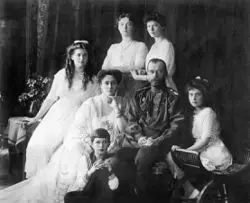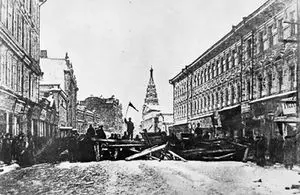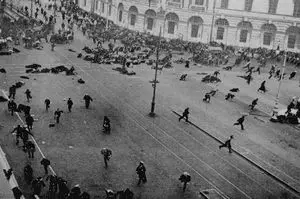Why did the Russian Romanov Dynasty collapse in 1917
The Russian Romanov dynasty collapsed in the chaos of the Russian Revolution of 1917. The rise of the Soviet Union from the Romanovs' ashes is perhaps the most important event in the twentieth century. It saw the world’s first Communist government, and it led to a wave of communist-inspired revolutions around the world and, ultimately, the Cold War. The Revolution is often inevitable because of the unequal nature of Russian society and its undemocratic political system. However, the Russian Revolution was not unavoidable and directly resulted from the impact of the First World War on Russia.
At the turn of the 20th Century how was Russia changing?
Russia was and is a vast and diverse country with a huge multi-ethnic population. The Russian Empire was an autocracy, where effectively the Tsar’s will was the law. Tsar Nicholas II ‘indulged in a fantasy of absolute power,’ and he believed that God had appointed him to the throne.[1] The Tsarist government repressed any signs of organized dissent, and as a result, there were many political prisoners. Russia was changing in the early years of the twentieth century. It was rapidly industrializing, and the country’s economy was growing fast.[2]
A new industrial class of workers was emerging, and society was becoming increasingly urbanized. However, this class was impoverished and lived and worked in appalling conditions. The majority of the population were still peasants that often worked the land for wealthy landlords and endured lives of great hardship. The industrial workers and the peasants did not benefit from the economic expansion in any way. Russia’s economic growth did create a new middle class. However, this class was excluded from the political system and resented the Tsar’s restrictions on its political and personal freedoms. Only the aristocracy and the elite supported the Tsarist government and just out of self-interest.
1905 Revolution
There was widespread discontent in the Russian Empire. Since the 1890s, various terrorist organizations had waged a violent campaign against the Tsar’s regime. There were many radical political parties active in the country, including the Bolshevik party. [3] Many people believed that Russian was ripe for a revolution. In 1905 Russia was routed by the Japanese Empire in a brief war in North-East Asia. This defeat was a national humiliation, and the Tsar and his government became very unpopular.Immediately, those who were unhappy with the existing system began to agitate for change. When Cossacks violently broke up a demonstration in St Petersburg, with many deaths, the country saw widespread revolts. The Tsar faced losing power and made significant concessions to secure his position. He granted a constitution and allowed for the creation of an elected Duma. This parliament then limited his powers.[4] This managed to appease the revolutionaries, and order and calm were restored. The Tsar promised reforms, including land reform, and vowed to respect the constitution. In the years following, Nicholas II failed to implement meaningful reforms, although some ‘real and positive changes.[5] The economy improved after 1905, and the Tsar began to win back some support. However, radicals were unhappy with the situation and plotted revolution, either in Russia or in exile, such as Lenin, the Bolshevik Party of Communists in Switzerland.
World War I
In 1913 there were lavish public celebrations of the 300th anniversary of the Romanov Dynasty’s rule in Russia. The Tsar used the anniversary to demonstrate that God appointed him to rule ‘all the Russia’s.[6] That year, the Tsar and his family were very popular, and it seemed to the revolutionaries that there would never be a revolution. However, after the assassination of Archduke Ferdinand, Europe was plunged into war. Russia was allied with France and Britain against Germany, Austro-Hungary, and Turkey. Russia invaded Prussia in 1914, but after some initial success, was defeated. It also fought campaigns against the Ottoman and Austro-Hungarian Empires.

The war on the Eastern Front became bogged down in trench warfare. Russia endured hefty casualties, and it placed a great strain on its resources. Food supplies became scarce, and poverty spread across Russia. Essentially, the lives of most Russians became intolerable. The Tsarist government became very unpopular. A scandal also made the Tsar and his family hated by many. A Siberian holy man called Rasputin, gained great influence with the Tsar and his family, as he claimed to have the ability to heal the crown prince’s hemophilia. This brought him ‘immense power and prestige at Court,’ but it scandalized many.[7] By 1917, the Russian people were war-weary, and strikes became very common. The Tsar refused to enter into peace negotiations with the Central Powers, despite several defeats on the Eastern Front and ordinary people's suffering.
February and October Revolutions 1917
By February 1917, the situation was unbearable for the average Russian soldier and citizens. A series of strikes were staged in St. Petersburg, and the Tsar ordered the army to break the strikes. Instead, the army mutinied and began to fraternize with the strikers.[8] The authority of the Tsar ebbed away, and he was forced to abdicate. A Provisional Government that claimed to represent the workers and the peasants took power. This became known as the October Revolution.[9]
However, following the Tsarist government's collapse, many local committees are known as Soviets and took power all over Russia. They often refused to recognize the authority of the Provisional Government. Many of the Soviets were dominated by the Bolsheviks or Communists loyal to their exiled leader Lenin. The Provisional government wanted to continue with the war, which made it very unpopular with many, especially the Soviets. Radical groups like the Bolsheviks stated that they wanted to bring an end to the war. They also made themselves very popular by promising food to the people and the redistribution of land. Their slogan was ‘Peace and Bread.’ The Provisional Government was fast losing control of the situation. Russian soldiers began deserting, and the army was close to defeat. However, the leader of the Provisional Government, Alexander Kerensky, refused to compromise. This was to prove fatal.
Lenin organized his Bolshevik forces and decided to stage a revolt that would seize Petrograd's power (formerly known as St Petersburg). On the night of October, they seized the Winter Palace and ousted the Provisional Government. The event became known as the October Revolution. The next day the world was amazed to hear of the first Communist government in history. However, only after a brutal civil war resulted in millions of deaths that the Communist were able to take full control of Russia.
Conclusions
Many factors caused the Russian Revolution. The autocratic Tsarist regime was unwilling to change with their society. The Regime's repressive policies and scandals further undermined its legitimacy. However, this did not make the Russian Revolution inevitable. The catalyst for the revolution was the First World War. It accentuated the tensions in Russian society and unleashed forces that the Romanov regime could not control. The suffering people and the common soldiers grew impatient and demanded immediate change and, above all, peace. The failure of the Tsarist regime to end the war resulted in the collapse of the Romanov Dynasty.
Related DailyHistory.org Articles
References
- ↑ Figes, Orlando. A People's Tragedy: The Russian Revolution: 1891-1924(Pimlico, 1996), p. 23
- ↑ Figes, p. 86
- ↑ Wood, Alan (1993). The Origins of the Russian Revolution, 1861-1917. London: Routledge
- ↑ Figes, p. 65
- ↑ Lincoln, W. Bruce. Passage Through Armageddon: The Russians in War and Revolution, 1914–1918. (New York, 1986), p. 4.
- ↑ Figes, p. 117.
- ↑ Figes, p. 31.
- ↑ Robert Service (2005). A history of modern Russia from Nicholas II to Vladimir Putin. Harvard University Press
- ↑ , Malone, Richard (2004). Analyzing the Russian Revolution. Australia: Cambridge University Press. p. 67.
Admin, Ewhelan and EricLambrecht
Updated January 19, 2019



